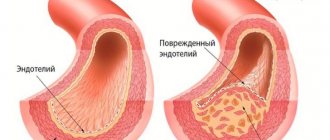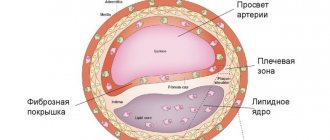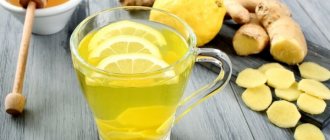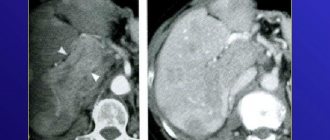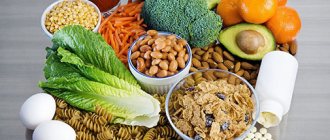Around the so-called “vascular cleansing”
A whole industry and many myths have developed.
However, our blood vessels are not pipes; even theoretically, cleaning them to get rid of cholesterol plaques or calcium deposits is not at all so simple. Does “vascular cleaning” even exist, or is it a misconception and a marketing ploy? We talked with our expert - cardiologist, functional diagnostics doctor, candidate of medical sciences Anna Nikolaevna Kotelnikova
, to learn more about the prevention and treatment of atherosclerosis.
On the eve of the New Year and the festive feast, be attentive to your diet and take care of yourself!
Vessel cleaning - what is it?
In official medical terminology, there is no such thing as “cleaning blood vessels” - this is everyday slang that is misleading and creates confusion. Unfortunately, it is impossible to remove cholesterol plaques that have already formed and clean a clogged vessel like a water pipe using a magic cleaning agent or “nanothreads”. An entire industry has already formed around the cleaning of blood vessels, however, the drugs and procedures that are offered to solve the problem do not have proven clinical effectiveness, the same applies to traditional methods. Restoring the functional state of the vascular endothelium is much more serious than detox, which is only appropriate for the primary prevention of vascular blockage. With atherosclerosis, when the vessels are narrowed by less than 50%, there is a risk of blood clots, heart attack or stroke
, the doctor prescribes drug therapy (
statins
,
calcium antagonists
and other drugs). However, they do not remove plaques, but compact them, thus increasing the lumen of the vessel. Therefore, it is extremely important to adhere to simple recommendations for the prevention of atherosclerosis.
In colloquial language, “cleaning” is also called cardiac surgery to expand a dangerously narrowed vessel - angioplasty, bypass surgery, stenting
. Their methods differ, but the essence is approximately the same: a catheter is inserted into the vessel, and the damaged, pathologically narrowed area is straightened and strengthened from the inside using implants - special rings, springs or tubes. The need for such operations arises if an atherosclerotic plaque closes the lumen of the vessel (artery) by more than 50%. When the blood supply is so disrupted, cells and organs are not supplied with oxygen and nutrients, and a person’s life can hang by a thread. It happens that a vessel or artery is blocked by a blood clot - a person suddenly feels very tired to the point of loss of consciousness, rapid heartbeat, suspicious pain (headaches, in the area of the heart), suffocates, and the skin turns pale. Such conditions are considered acute, and as a “cleansing” procedure, thrombolysis with special drugs is used on an outpatient basis. After stenting, bypass surgery or angioplasty, blood supply is restored, but it is necessary to take special medications and be observed by a cardiologist.
Habits that damage blood vessels in your legs every day
Some habits have a detrimental effect on health and, first of all, this concerns blood vessels. The structure of blood vessels can be disrupted by:
- Insufficient physical activity. As you know, life is movement. A person needs to constantly move to keep the blood vessels in good shape. You should not stay in one position for a long time; change the position of your legs every 20 minutes. And don’t forget to do simple exercises in the morning and evening; it won’t take much time, but it will be a good prevention of varicose veins on the legs.
- Excessive loads. A person needs to move, but you shouldn’t overexert your body. Due to intense training and exercise in the gym, work in the country, heavy lifting and other loads, pressure in the vessels of the lower extremities increases significantly, which leads to stretching of the muscle fiber and the development of valvular insufficiency.
- Smoking has a negative effect not only on the respiratory system, but also on the blood vessels of the entire body. Toxic tobacco tars, entering the blood, destroy the walls of blood vessels and reduce their elasticity.
- Wrong wardrobe. Fashionable jeans that are tight around the legs and pelvis, socks with a tight elastic band, and tight, tight shoes disrupt the normal blood flow in the lower extremities, thereby causing swelling and blood stagnation.
- Overheating of the body. High temperatures cause the vessels to expand to their limits. Frequent and/or long periods of time in a bathhouse, under the scorching sun or on the beach also contribute to the dilation of blood vessels, which reduces their elasticity. And these are the first prerequisites for the development of varicose veins on the legs.
- Abuse of massage and anti-cellulite procedures. Too frequent active, lymphatic drainage and anti-cellulite massages and wraps also affect the condition of the walls of blood vessels. Before carrying out even health-improving cosmetic procedures, it is necessary to consult with a therapist or specialist at a treatment center.
The first signs of varicose veins on the legs are abundant purple or deep red bruises, large bruises. If you notice bruising for no apparent reason, consult a doctor immediately.
Why do blood vessels become clogged?
Vessels become blocked for various reasons, but most often this occurs due to cholesterol plaques and the deposition of calcium salts (calcinosis). The mechanism for the formation of such blockages is more complex than it seems, and it lies behind our everyday habits - even the most harmless at first glance. For example, when we eat highly salty foods
, blood thickening and fluid retention occur - blood pressure increases.
When we experience stress
, the hormones adrenaline and norepinephrine are produced - key vessels narrow, and pressure increases because the amount of blood that the heart needs to push remains unchanged. In a normal healthy state, the vessels cope with such loads, but over time, serious problems can begin, and this is not only hypertension.
Proven pharmaceutical herbal remedies
In addition to ready-made herbal infusions, you can also purchase medications in pharmacy chains, the composition of which is based on herbs. However, such medications most often have a narrow focus of action and may not be suitable for everyone. Therefore, consultation with a doctor before purchasing is required.
The most popular drugs are the following:
- Ginkgo biloba . Created on the basis of dry extract of Ginkgo biloba leaves. Indicated for circulatory disorders, tinnitus, memory and sleep disorders, feelings of fear;
- Preparations containing periwinkle . They help strengthen blood vessels and capillaries, improve cerebral circulation, and normalize heart function. Accelerate blood flow and relieve vascular spasms.
Causes of atherosclerosis
The fact is that due to systematic additional loads, microdamages can form on the walls of the arteries. Damaged tissues swell. Cells that respond to inflammation (for example, white blood cells) accumulate around the damage, and fat and cholesterol that float in the blood also cling to them - a cholesterol plaque is formed. It is no longer possible to get rid of it using completely non-invasive methods. At the same time, the walls of the vessels become coarser and thinner - this pathological condition is called atherosclerosis, which in turn can lead to coronary artery disease and causes the need for “cleansing of blood vessels”.
Thus, it is important not only to eat right, but also to maintain the functional state of the cardiovascular system.
What herbs constrict blood vessels?
There are not many herbs that have a vasoconstrictor effect. Most often they are used for varicose veins. Among the most effective are:
- Horse chestnut . Based on it, many drugs are created for the treatment of varicose veins. It helps strengthen the walls of the arteries, narrow the vessels of the head, relieve pain, eliminate inflammation and itching;
- Witch hazel . Contains tannins, flavonoids and saponins, which help restore strength to weakened vascular channels and improve blood flow. The astringent properties of the plant allow you to constrict blood vessels and prevent bleeding;
- Cypress . One of the components used to combat certain cardiovascular pathologies, especially if they are accompanied by inflammation and the formation of blood clots. It is effective to use infusion and decoction of this plant as tea.
Good and bad cholesterol
There are several types of lipoproteins (cholesterols). Low-density lipoproteins
(LDL)
are considered bad , but there is also a good one -
high-density lipoproteins (HDL)
. The latter works almost as an antagonist of bad cholesterol, allows you to control lipid metabolism - helps in transporting substances and detoxifying the body from bad cholesterol. Below we will tell you how to maintain the correct LDL-HDL balance and what else you need to pay attention to.
Prevention of vascular atherosclerosis
Avoid foods with high cholesterol levels
Limit animal products with high cholesterol content in your diet: lard, fatty meat, offal, fatty dairy products and whole milk, egg yolk. This does not mean that you need to completely abandon animal proteins and fats. The menu should be dominated by vegetables and fruits, complex carbohydrates and cereal fibers, especially fiber. It is important to control sugar levels and not overindulge in sweets and starchy foods - it is better to replace chocolate bars and snacks with dried fruit sweets and nuts, and your body will thank you.
The method of preparing dishes also plays an important role
- before you put meat or scrambled eggs in oil on a hot sizzling frying pan, think about whether it might be better to steam it? It is forbidden? Okay, but for frying it is better to use vegetable oils, such as olive oil.
Citrus fruits also fight fat and cholesterol
, in particular the substance pectin, isolated from
grapefruit
.
Pectin
is a soluble fiber that is found only in citrus fruits themselves, but not in juice.
We get cholesterol from 2 main sources. Most of the cholesterol (about 1 g per day) is produced by our liver - and this is enough.
We get the other part directly from food.
There is another life hack: pay attention to labels in the store, try to avoid products labeled “partially hydrogenated fats”
.
Play sports - train your heart and blood vessels
WHO recommends at least 150 minutes of physical activity per week.
During training, the body is detoxified, and the blood vessels are strengthened - this is also a kind of “cleansing of blood vessels.”
Even after undergoing stenting/bypass surgery, you can play sports and even run a marathon. However, such patients first need to take medications for quite a long time and be observed by a doctor. Patients with cardiovascular diseases need to calculate the permissible level of physical activity and select its optimal option. bicycle ergometry is for.
, which allows you to take stress tests on a device similar to a bicycle with special sensors.
Check your cholesterol levels
Once a year, it is recommended to take a special blood test - a lipid profile - to see if there is an increase in the level of total cholesterol or its fractions. In this way, it is possible to understand in a timely manner whether everything is fine with lipid metabolism or whether drug correction is necessary.
Primary prevention of atherosclerosis and blockage of blood vessels also involves visiting a therapist or cardiologist once a year, even if there are no complaints.
Treat periodontal disease, control sugar levels and body weight
Everything in our body is interconnected. It has been proven that patients with periodontal disease, like patients with diabetes and overweight, are more predisposed to atherosclerosis.
In 2021, the study “Metabolic syndrome and periodontal disease: An overview for physicians”
(Srivastava MC, Verma PK) with important and very interesting conclusions. In patients with poor teeth and a predisposition to atherosclerosis, intensive periodontal therapy after 2 months showed a significant reduction in the levels of c-reactive protein, interleukin-6 and low-density lipoprotein cholesterol.
Measure your blood pressure
The absolute norm for blood pressure in an adult is considered to be 120/80 mmHg, but depending on the individual characteristics of the body, deviations are possible.
Monitor calcium levels and nutrient balance in the body
It is recommended to take additional Omega-3
- the body does not synthesize these beneficial fatty acids on its own - and you need to eat a lot of seafood and season salads only with flaxseed oil to make up for this deficiency. Omega 3 polyunsaturated fatty acids are the basis not only for strong and clean blood vessels, but even a building material for the brain. The average adult is recommended to consume 250 mg of Omega 3 per day throughout his life.
Vitamin K3
prevents calcium from being washed out of the bones and deposited on the walls of blood vessels. Most K₂ is found in fermentation products: cheese and fermented milk products.
Vitamin D and C, coenzyme Q10 are also extremely important for blood vessels
Stay hydrated, give up bad habits and get enough sleep
Drink clean filtered water throughout the day - about 1.5 liters.
The permissible amount of alcohol per day, which does not harm your heart and blood vessels, is 1 glass of good quality red wine; it is better to completely give up smoking.
You can get the maximum benefit from sleep if you sleep for 7-8 hours in a comfortable environment, without light or gadgets, and wake up only with or without an alarm clock.
What does strength affect?
Black tea gains its strength on average 5 minutes after the start of brewing, green tea - after 7 minutes. At this moment, teas have the best aroma and taste. Later, the drink becomes not stronger, but richer in color, but loses the properties that fully characterize the strength: essential oils evaporate, vitamins decompose, etc.
At the moment of its highest strength, tea has the greatest effect on the blood vessels of the brain and heart.
Sometimes a strong drink helps improve the condition. For example, strongly brewed black tea for headaches and low blood pressure will relieve spasms, raise blood pressure and prevent it from falling again.
But a large amount of strong green tea, even in a hypotensive person, can immediately cause unpleasant symptoms:
- problems with the thyroid gland;
- strong heartbeat;
- trembling of hands and feet;
- sleep disorders.
Therefore, it is strongly advisable to brew only black tea and only if we are talking about hypotensive people who do not experience sudden surges in pressure. But a medium-strength drink will help him just as well, without giving any side effects.
Any weak tea can bring down elevated body temperature. A strong one should never be used for this: on the contrary, it increases the heat.
Women and men over 40 years old
Patients in the older age group should be especially attentive to the state of the cardiovascular system and the primary prevention of atherosclerosis. Statistically, men are more susceptible to this disease, and hormones play an important role in this.
During the reproductive period, a woman’s ovaries produce sexual estrogens, which regulate the content of fats in the blood and prevent the deposition of cholesterol on the walls of blood vessels, that is, they protect the woman’s body from atherosclerosis.
During menopause, ovarian function declines, they stop producing estrogen, and its content in the blood drops sharply. This leads to the fact that cardiovascular diseases in women after menopause appear 5 times more often than before it.
Therefore, at this age it is recommended to consult a gynecologist-endocrinologist.
, who may prescribe menopausal hormone therapy if necessary. MHT can not only improve the quality of life and prolong it, but also preserve beauty from the inside.
Doctors at the Cardiology Center of the Pirogov Clinic provide qualified assistance to patients in the treatment of atherosclerosis, preventive diagnostics, as well as recovery after stenting, bypass surgery, and a heart attack.
You can make an appointment with a cardiologist or directly with Dr. Anna Nikolaevna Kotelnikova through our website.
How hot should it be?
The optimal temperature for drinking is considered to be around 56 degrees. Being hotter, it provokes malignant formations of the throat and stomach; if it is overcooled, it reduces its healing properties.
However, in culture, for example, American civilization, it is practically not customary to drink this drink hot.
Eastern traditions suggest that the more fermented the tea, the hotter it should be consumed: otherwise it is tasteless and does not provide any beneficial effect.
Accordingly, white and green teas can be drunk even cold , if such consumption is comfortable. Provided they are chilled but fresh.
